Germany
 When Hitler took power in Germany, the first goal was to take away the guns from the people. He then dismantled the police, and set up his own police force…loyal only to him. This was the beginning of Hitler’s planned takeover…first of Germany, and then the world. That was his goal, but thankfully, the world fought back, and evil did not prevail.
When Hitler took power in Germany, the first goal was to take away the guns from the people. He then dismantled the police, and set up his own police force…loyal only to him. This was the beginning of Hitler’s planned takeover…first of Germany, and then the world. That was his goal, but thankfully, the world fought back, and evil did not prevail.
World War II had gone on for almost five years…long years. Hitler’s forces were reeling from the devastating effects of D-Day, and Paris was next in line for liberation, The Allied machine was marching in to Paris to remove the Nazi Regime. Hitler was furious, and decided that if his army was to be forced out, they would take the best of the memories and landmarks of Paris with them. He planned to leave the city in smoldering ruins. Hitler issued the first of several orders to the German commander of Paris, General Dietrich von Choltitz, to destroy the city. What Hitler had not anticipated, was that von Choltitz would not blindly do his bidding. The last last commander of Nazi-occupied Paris in 1944, von Choltitz disobeyed Adolf Hitler’s orders to destroy the city, and instead surrendered it to Free French forces when they entered the city on August 25th. Choltitz later asserted that his defiance of Hitler’s direct order stemmed from its obvious military futility, his affection for the French capital’s history and culture, and his belief that Hitler had by then become insane, while other sources point to the fact that he had little control of the city thanks to the operations of the resistance, and could not have carried out such orders. Nevertheless, von Choltitz has since been referred to as “The Saviour of Paris.”
As I look at the current circumstances in the United States, I am reminded of the days of Hitler’s reign of terror. The riots in the streets, the calls for gun control and defunding the police, and the removal of the statues marking our past…good and bad, are all reminiscent of the days of early World War II. Just as in the days of 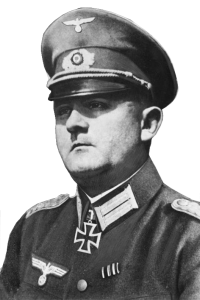 Hitler’s National Socialist Party, Socialism would not be good for America either. While the Democratic Party voters should understand that their values are like Hitler’s and yet, often blame the Republican party for being like Hitler, they are wrong. If they would look at history, instead of trying to remove our memory of the past, they would see just how alike Socialism is to Nazism and Hitler’s ways. Truly, the people of the United States need to wake up…and quickly. The decision to try to change our country to Socialism, is a slippery slope to communism, and the removal of the freedoms we hold so dear. We need to approach our future with our eyes wide open about the past of other nations, as well as the greatness that the American system of Capitalism has provided our nation with in the past. We like our freedom to let our voice be heard…a right that is found only in Capitalism. Don’t let the rights and privileges we so enjoy, be stolen from us by a handful of radical Socialists and Communists. The time to stand against Socialism and Communism is now!! Wake up America!!
Hitler’s National Socialist Party, Socialism would not be good for America either. While the Democratic Party voters should understand that their values are like Hitler’s and yet, often blame the Republican party for being like Hitler, they are wrong. If they would look at history, instead of trying to remove our memory of the past, they would see just how alike Socialism is to Nazism and Hitler’s ways. Truly, the people of the United States need to wake up…and quickly. The decision to try to change our country to Socialism, is a slippery slope to communism, and the removal of the freedoms we hold so dear. We need to approach our future with our eyes wide open about the past of other nations, as well as the greatness that the American system of Capitalism has provided our nation with in the past. We like our freedom to let our voice be heard…a right that is found only in Capitalism. Don’t let the rights and privileges we so enjoy, be stolen from us by a handful of radical Socialists and Communists. The time to stand against Socialism and Communism is now!! Wake up America!!
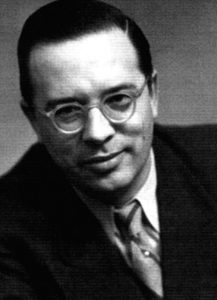 During the Holocaust, the majority of known Jews in any given country, had a very slim chance of surviving the war, but the Denmark Jews somehow managed to hold an impressive 95% survival rate record. Much of that was due to one man, Georg Ferdinand Duckwitz, who became an unlikely hero of the Jewish people…mainly because he was a German diplomat serving as an attaché for Nazi Germany in occupied Denmark at the time. In fact, that is what makes what he did so strange.
During the Holocaust, the majority of known Jews in any given country, had a very slim chance of surviving the war, but the Denmark Jews somehow managed to hold an impressive 95% survival rate record. Much of that was due to one man, Georg Ferdinand Duckwitz, who became an unlikely hero of the Jewish people…mainly because he was a German diplomat serving as an attaché for Nazi Germany in occupied Denmark at the time. In fact, that is what makes what he did so strange.
Duckwitz was born on September 29, 1904, in Bremen, Germany. He was part of an old patrician family in the Hanseatic City. After college, he began a career in the international coffee trade. From 1928 until 1932 Duckwitz lived in Copenhagen, Denmark. Upon moving back to Bremen, November 1932 he met Gregor Strasser, who was the leader of the leftist branch of the German nationalistic Nazi Party. While talking to Strasser, Duckwitz found that “elements of Scandinavian socialism [were] connected with nationalistic feelings” and this led to his decision to join the Nazi Party, and subsequently on July 1, 1933, to join the Nazi Party’s Office of Foreign Affairs in Berlin.
What had at first seemed to him to be a party who’s values agreed with his, he soon became increasingly disillusioned by Nazi politics. In a letter written June 4, 1935 to Alfred Rosenberg, the head of the office, he wrote, “My two-year employment in the Reichsleitung [i.e. executive branch] of the [Nazi Party] has made me realize that I am so fundamentally deceived in the nature and purpose of the National Socialist movement that I am no longer able to work within this movement as an honest person.” That move in itself strikes me now, as scary, considering how the known Nazi party functioned. He may not have realized hoe dangerous his words were, but I think they could have gotten him killed. Around the same time the Gestapo (secret police) made its first notes on Duckwitz after he sheltered three Jewish women in his Kurfürstendamm apartment during a local anti-Semitic Sturmabteilung event. He later wrote that during this time period he became “a fierce opponent of this [Nazi] system”.
After 1942, Duckwitz worked with the Nazi Reich representative Werner Best, who organized the Gestapo. On September 11, 1943 Best told Duckwitz about the intended round-up of all Danish Jews on October 1, 1943. A horrified Duckwitz travelled to Berlin in an attempt to stop the deportation through official channels. When that failed, he flew to Stockholm two weeks later, saying he was going to discuss the passage of German merchant ships. While there, he contacted Prime Minister Per Albin Hansson and asked whether Sweden would be willing to receive Danish Jewish refugees. A couple of days later, Hansson came back with the promise of a favorable reception. On September, 29, 1943, Duckwitz contacted Danish social democrat Hans Hedtoft and notified him of the intended deportation. Hedtoft warned the head of the Jewish community CB Henriques and the acting chief rabbi Marcus Melchior, who spread the warning. Sympathetic Danes in all walks of life organized an immediate mass escape of over 7,200 Jews and 700 of their non-Jewish relatives by sea to Sweden. Duckwitz’ immediate action and the willingness of the Danish and Swedish citizens saved the lives of 95% of Denmark’s Jewish population. They were the only European nation to save almost all their Jewish population from certain death at the hand’s of Hitler’s evil regime.
Somehow, Duckwitz was never caught committing his act of “treason” against the Third Reich, and he stayed in good standing with the Nazi regime. After the war, Duckwitz remained in the German foreign service. From 1955–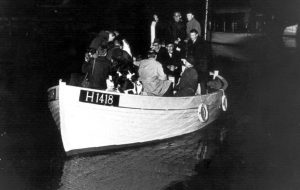 1958 Duckwitz served as West German ambassador to Denmark and later as the ambassador to India. When Willy Brandt became Foreign Minister in 1966, he made Duckwitz Secretary of State in West Germany´s Foreign Office. After Brandt became Chancellor, he asked Duckwitz to negotiate an agreement with the Polish government. Brandt’s work culminated in the 1970 Treaty of Warsaw. Duckwitz worked as Secretary of State until his final retirement in 1970. On March 21, 1971 the Israeli government named him Righteous Among the Nations and included him in the Yad Vashem memorial. He died two years later, on February 16, 1973 at the age of 68.
1958 Duckwitz served as West German ambassador to Denmark and later as the ambassador to India. When Willy Brandt became Foreign Minister in 1966, he made Duckwitz Secretary of State in West Germany´s Foreign Office. After Brandt became Chancellor, he asked Duckwitz to negotiate an agreement with the Polish government. Brandt’s work culminated in the 1970 Treaty of Warsaw. Duckwitz worked as Secretary of State until his final retirement in 1970. On March 21, 1971 the Israeli government named him Righteous Among the Nations and included him in the Yad Vashem memorial. He died two years later, on February 16, 1973 at the age of 68.
 People aren’t usually evil. Nor are the easily accepting of evil. Usually, in order to get people to accept evil, it has to be hidden in a way. It has to be slipped in when they aren’t looking…slowly, so that it is accepted as normal…or a new normal. When Hitler ordered the systematic murder of the mentally ill and handicapped people in 1939, the people of Germany were outraged. Never before had any leader made such a boldly, callous move. Like throwing a frog in a pot of boiling water, they jumped…fought back.
People aren’t usually evil. Nor are the easily accepting of evil. Usually, in order to get people to accept evil, it has to be hidden in a way. It has to be slipped in when they aren’t looking…slowly, so that it is accepted as normal…or a new normal. When Hitler ordered the systematic murder of the mentally ill and handicapped people in 1939, the people of Germany were outraged. Never before had any leader made such a boldly, callous move. Like throwing a frog in a pot of boiling water, they jumped…fought back.
Hitler moved too fast, and the people rebelled. The program, known as Hitler’s Euthanasia Department that began in 1939, came under the heading of unhidden evil. Hitler misjudged his people. He thought they would follow blindly along. When they began complaining about the T.4 program, which began as the systematic killing of children deemed “mentally defective,” Hitler had to act. He had been transporting children from all over Germany to a Special Psychiatric Youth Department and killing them. Later, certain criteria were established for non-Jewish children. They had to be “certified” mentally ill, schizophrenic, or incapable of working for one reason or another. Jewish children already in mental hospitals, whatever the reason or whatever the prognosis, were automatically to be subject to the program. The victims were either injected with lethal substances or were led to “showers” where the children sat as gas flooded the room through water pipes. The program was then expanded to adults. The program was heinous in every way.
Before long the outraged protests began mounting within Germany, especially by doctors and clergy. Some of them even dared to write to Hitler directly and describe the T.4 program as “barbaric.” Others circulated their opinions more discreetly. Heinrich Himmler, was the head of the SS then, and the man who would direct the systematic extermination of European Jewry. Himmler had only one regret…that the SS had not been put in charge of the T.4 program. He says of the protesting, “We know how to deal with it correctly, without causing useless uproar among the people.” Finally, in 1941, Bishop Count Clemens von Galen denounced the euthanasia 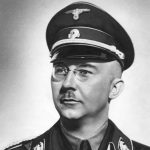 program from his pulpit. Hitler was concerned that other nations would get involved with such publicity about his program. He ordered the program suspended on August 18, 1941…at least in Germany. But 50,000 people had already fallen victim to it.
program from his pulpit. Hitler was concerned that other nations would get involved with such publicity about his program. He ordered the program suspended on August 18, 1941…at least in Germany. But 50,000 people had already fallen victim to it.
Hitler was not to be deterred. He now knew that he had to keep his programs hidden, if he was going to be able to carry out his plans. So, he revived the program in occupied Poland. The people there already had no say in the matter, and he hoped that it would be far enough from Germany so that the German people would not know what was going on. It worked for a time, but in the end, the world would know about the evil he tried so hard to keep hidden, and in the end the number of murder victims was far more than a mere 50,000…it was more like 11 million people.

 How could such a small island, sitting in the middle of the Mediterranean Sea, have such a large impact during World War II? Malta is only 95 square miles, the largest of the three islands that make up the Maltese archipelago, and it had a population of 433,082 in 2019, so imagine how small the population was during World War II. Nevertheless, the British Crown Colony of Malta was a strategic location and made a pivotal contribution to the air war in the Mediterranean during World War II. I don’t suppose they wanted to be in such a position, and considering the loss of civilian lives, 1,300 in all, they paid a dear price for the war effort.
How could such a small island, sitting in the middle of the Mediterranean Sea, have such a large impact during World War II? Malta is only 95 square miles, the largest of the three islands that make up the Maltese archipelago, and it had a population of 433,082 in 2019, so imagine how small the population was during World War II. Nevertheless, the British Crown Colony of Malta was a strategic location and made a pivotal contribution to the air war in the Mediterranean during World War II. I don’t suppose they wanted to be in such a position, and considering the loss of civilian lives, 1,300 in all, they paid a dear price for the war effort.
With the opening of a new front in North Africa in June 1940, came an increase to Malta’s already considerable value. There were British air and sea forces based on the island, who were able to attack the Axis ships transporting vital supplies and reinforcements from Europe. Winston Churchill called the island an “unsinkable 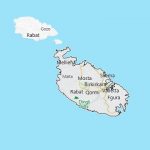
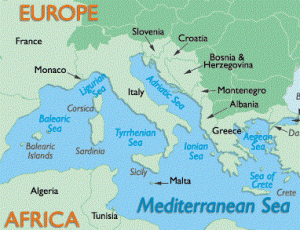
 aircraft carrier.” Of course, Malta was a lot bigger, but it was in the sea, and it did have an air base, so it was like a large aircraft carrier. Churchill’s analogy makes sense in that planes could be dispatched from there and return to there as needed during fighting. General Erwin Rommel, the field command of Axis forces in North Africa, recognized its importance quickly. In May 1941, he warned that “Without Malta the Axis will end by losing control of North Africa.”
aircraft carrier.” Of course, Malta was a lot bigger, but it was in the sea, and it did have an air base, so it was like a large aircraft carrier. Churchill’s analogy makes sense in that planes could be dispatched from there and return to there as needed during fighting. General Erwin Rommel, the field command of Axis forces in North Africa, recognized its importance quickly. In May 1941, he warned that “Without Malta the Axis will end by losing control of North Africa.”
Being a strategic centerpiece did not, guarantee Malta’s safety. In fact, the opposite was the case. Both sides needed Malta, but only the Allies had it, so the Axis nations decided to destroy it. Between 1940 and 1942, Malta faced relentless aerial attacks by the Luftwaffe and Italian Air Force. The Royal Navy and Royal Air Force both fought to defend the island and keep it supplied. Malta was essential to the Allied war effort to disrupt Axis 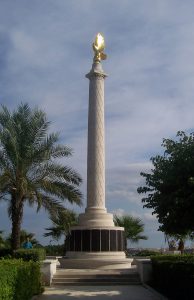
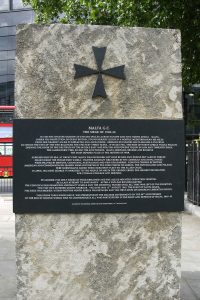 supply lines to Libya, and also for supplying British armies in Egypt. The German and Italian high commands also realized the danger of a British stronghold so close to Italy. Malta was a danger to the Axis nations, and they were bent on wiping it off the face of the earth. Malta had a target on it, and they began to feel like the shooting range.
supply lines to Libya, and also for supplying British armies in Egypt. The German and Italian high commands also realized the danger of a British stronghold so close to Italy. Malta was a danger to the Axis nations, and they were bent on wiping it off the face of the earth. Malta had a target on it, and they began to feel like the shooting range.
Through the course of the war, Malta was bombed so many times that in the end, that in April 1942, the people of Malta were collectively awarded the George Cross by King George VI, which is the highest award for civilian courage and heroism. It is the only time that an entire nation received such an honor. The award was considered such an honor that the nations flag proudly displays the George Cross.
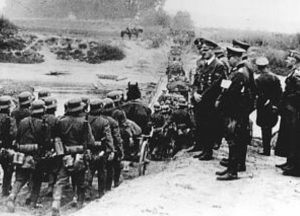 While Germany was not able to bring home the victory in World War II, they were a formidable enemy early in the war. On April 9, 1940, Nazi Germany launched an invasion into Norway. The initial attack was successful, and the Nazis captured several strategic points on the Norwegian coast. Hitler didn’t care that Norway had declared neutrality at the outbreak of World War II. Hitler wanted to rule the world and Norway was part of what he wanted.
While Germany was not able to bring home the victory in World War II, they were a formidable enemy early in the war. On April 9, 1940, Nazi Germany launched an invasion into Norway. The initial attack was successful, and the Nazis captured several strategic points on the Norwegian coast. Hitler didn’t care that Norway had declared neutrality at the outbreak of World War II. Hitler wanted to rule the world and Norway was part of what he wanted.
During the preliminary phase of the invasion, Norwegian fascist forces under Vidkun Quisling acted as a so-called “fifth column” for the German invaders, seizing Norway’s nerve centers, spreading false rumors, and occupying military bases and other locations. They were the invaders from within. 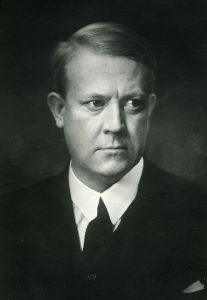 Quisling agreed with Hitler concerning the “Jewish problem” and became the leader of Norway during the Nazi occupation. Prior to that Quisling served as the Norwegian minister of defense from 1931 to 1933, and in 1934 he left the ruling party to establish the Nasjonal Samling, or National Unity Party, which was an imitation of Adolf Hitler’s Nazi Party.
Quisling agreed with Hitler concerning the “Jewish problem” and became the leader of Norway during the Nazi occupation. Prior to that Quisling served as the Norwegian minister of defense from 1931 to 1933, and in 1934 he left the ruling party to establish the Nasjonal Samling, or National Unity Party, which was an imitation of Adolf Hitler’s Nazi Party.
Norway’s declaration of neutrality didn’t do them much good when their own minister of defense was a traitor. Norway’s declared neutrality at the outbreak of World War II, was simply a small stumbling block in the plan Nazi Germany had. Hitler regarded the occupation of Norway a strategic and economic necessity. In the spring of 1940, Vidkun Quisling met with Nazi command in Berlin to plan the German conquest of his country. The Norwegian people have no warning on April 9th, when the combined German forces attacked, and by June 10th Hitler had conquered Norway and driven all Allied forces from the country.
Being the head of the only political party permitted by the Nazis didn’t do Quisling 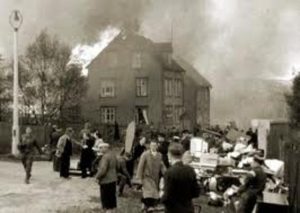 any good either. The people hated him, and opposition to him in Norway was so great that he couldn’t formally establish his puppet government in Oslo until February 1942. Nevertheless, the regime he set up under the authority of his Nazi commissioner, Josef Terboven, was a repressive regime that was merciless toward those who defied it. There was not peace for either side in those years. Norway’s resistance movement soon became the most effective in all Nazi-occupied Europe, and Quisling’s authority rapidly failed. After the German surrender in May 1945, Quisling was arrested, convicted of high treason, and shot. He was so hated that from his name comes the word quisling, meaning “traitor” in several languages.
any good either. The people hated him, and opposition to him in Norway was so great that he couldn’t formally establish his puppet government in Oslo until February 1942. Nevertheless, the regime he set up under the authority of his Nazi commissioner, Josef Terboven, was a repressive regime that was merciless toward those who defied it. There was not peace for either side in those years. Norway’s resistance movement soon became the most effective in all Nazi-occupied Europe, and Quisling’s authority rapidly failed. After the German surrender in May 1945, Quisling was arrested, convicted of high treason, and shot. He was so hated that from his name comes the word quisling, meaning “traitor” in several languages.
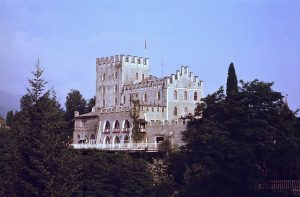 World War II was one time when the United States and Germany were absolutely not friends. The Nazi beliefs and the American beliefs were worlds apart. Nevertheless, not all Germans were Nazis, and hard to believe as that may be, it was true. Never was that more evident that at Castle Itter, a small fortification in Austria used by the SS during World War II as a prison for high profile detainees. On May 6, 1945, with the Third Reich collapsing against the Allied attacks, the German commander of Dachau, Wilhelm Weiter committed suicide. At that point, some of the Waffen SS soldiers retreated, and amid the chaos that followed, the opportunity presented itself, and a Yugoslav freedom fighter, Zvonimir Cuckovic, who was a prisoner at Dachau, escaped and went looking for some Allied troops to rescue the rest of the prisoners.
World War II was one time when the United States and Germany were absolutely not friends. The Nazi beliefs and the American beliefs were worlds apart. Nevertheless, not all Germans were Nazis, and hard to believe as that may be, it was true. Never was that more evident that at Castle Itter, a small fortification in Austria used by the SS during World War II as a prison for high profile detainees. On May 6, 1945, with the Third Reich collapsing against the Allied attacks, the German commander of Dachau, Wilhelm Weiter committed suicide. At that point, some of the Waffen SS soldiers retreated, and amid the chaos that followed, the opportunity presented itself, and a Yugoslav freedom fighter, Zvonimir Cuckovic, who was a prisoner at Dachau, escaped and went looking for some Allied troops to rescue the rest of the prisoners.
Hans Fuchs, who was a young student going to school nearby, remembers how Itter Castle was converted into a prison by the Nazis in 1943. He said, “We saw everything from our school window, a double barbed-wire fence…and floodlights so that the whole night was lit up like day.” Itter Castle, is an old castle, dating back to the Middle Ages. It was turned into a sub-unit of the Dachau concentration camp, and used for VIP prisoners, prominent politicians, and military figures that the Nazis wanted to use as bargaining chips. Famous prisoners 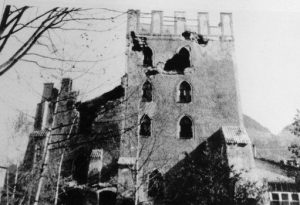 there included two former prime ministers of France, Edouard Daladier and Paul Reynaud, as well as the elder sister of Gen Charles de Gaulle, Marie-Agnes Cailliau.
there included two former prime ministers of France, Edouard Daladier and Paul Reynaud, as well as the elder sister of Gen Charles de Gaulle, Marie-Agnes Cailliau.
Cuckovic’s escape triggered one of the most curious battles of the conflict, but not in the way you might think. After he escaped, Cuckovic found an American armored column and got them to come with him. At the same time a Major Josef Gangl, who was an Austrian in the German Army, and had been collaborating with Austrian resistance in the closing days of the war, also intended to free the castle prisoners, but had decided instead to surrender with his men to the Americans. Gangl hated what was going on and knew that the Nazis were friends to no one. He could no longer stomach what he had been commanded to do. With the arrival of Cuckovic a hasty agreement took place. The major and his Wehrmacht troops would fight alongside the Americans against the SS guards.
The resulting battle of Castle Itter was not a major battle, just an amazing one. The SS faced not only their own countrymen and Americans, complete with a Sherman tank, but there were also Austrian partisans and French prisoners joining in. It was a wonderful show of the unifying effect the Allies had compared to the polarizing effect of the Nazis. The ensuing battle was not big, and in fact, a maximum of just 100 men were 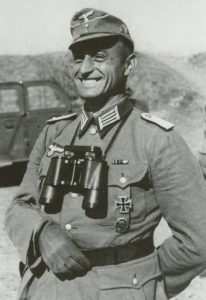 involved. Nevertheless, this battle was, without a doubt, vicious. The Sherman tank was destroyed and Major Josef Gangl was killed by a sniper. The thing that made this battle so unique, however, was that it was the only time the American army fought alongside the German army in all of World War II. The SS were handily defeated and quickly surrendered. The rest of the prisoners held at Castle Itter were released unharmed.
involved. Nevertheless, this battle was, without a doubt, vicious. The Sherman tank was destroyed and Major Josef Gangl was killed by a sniper. The thing that made this battle so unique, however, was that it was the only time the American army fought alongside the German army in all of World War II. The SS were handily defeated and quickly surrendered. The rest of the prisoners held at Castle Itter were released unharmed.
There have been times in many wars, when two soldiers made the conscious decision not to engage in battle, allowing both to live to fight another day. I suppose it would not be unheard of to have two opposing soldiers work together to defeat a common enemy, like maybe a bear or other wild animal, but for two army patrols of two opposing sides, to join forces against part of one sides army, is…well, unheard of. The battle at Castle Itter was just such a battle, and it is believed to be the only battle in the war in which Americans and Germans fought as allies.
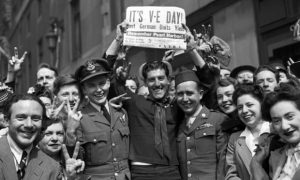 World War II was finally winding down. Germany had surrendered. Japan was still a problem, but they were losing their strength too. Hitler committed suicide on April 30, and now it was over for Germany. I fact, it was time for celebration. So on May 8, 1945, both Great Britain and the United States celebrated Victory in Europe Day. The day would come to be known as V-E Day, and cities in both nations, as well as formerly occupied cities in Western Europe, put out flags and banners, rejoicing in the defeat of the oppressive Nazi war machine.
World War II was finally winding down. Germany had surrendered. Japan was still a problem, but they were losing their strength too. Hitler committed suicide on April 30, and now it was over for Germany. I fact, it was time for celebration. So on May 8, 1945, both Great Britain and the United States celebrated Victory in Europe Day. The day would come to be known as V-E Day, and cities in both nations, as well as formerly occupied cities in Western Europe, put out flags and banners, rejoicing in the defeat of the oppressive Nazi war machine.
That was 75 years ago today that the first V-E Day was celebrated. It is hard to believe that it was 75 years ago. I wasn’t born then, of course, but over the years of researching World War II, I almost feel like those events were just yesterday. Researching World War II bought the events…good, bad, and horrific to life for me. Our men and women, as well as those of the Allies were brave and noble people. They were fighting against two oppressive regimes, both of whom had murdered their own people and the people of the nations around them. The Nazi war machine had marched through Europe, terrorizing the people around them. The Luftwaffe planes bombed many cities, taking no concern for the civilians lost. Life meant nothing to them…except for their own. Hitler was greedy for power, and wanted to bring Nazism to the whole world. Thankfully they were stopped before they could complete their reign of terror.
German troops throughout Europe finally laid down their arms on May 8, 1945 in Prague. The Soviets had lost 8,000 soldiers by the time of the surrender, but the Germans had lost considerably more. They laid down their arms too, in Copenhagen and Oslo, at Karlshorst, near Berlin, in northern Latvia, and on the Channel Island of Sark. The German surrender was almost complete in that final cease-fire. More surrender documents were signed in Berlin and in eastern Germany.
The main concern of many German soldiers was to elude the grasp of Soviet forces, to keep from being taken prisoner. About 1 million Germans attempted a mass exodus to the West when the fighting in Czechoslovakia ended, but were stopped by the Russians and taken captive. The Russians captured approximately 2 million 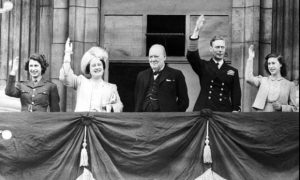 prisoners just before and after the German surrender. At the same time. 13,000 British soldiers were released and sent back to Great Britain. Of course, there were still pockets of confrontations into May 9th, and the Soviets lost an additional 600 soldiers in Silesia before the Germans finally surrendered. Those skirmishes pushed back the V-E Day celebration until the ninth in Moscow, with a radio broadcast salute from Stalin himself, “The age-long struggle of the Slav nations has ended in victory. Your courage has defeated the Nazis. The war is over.” It was a great day for all the people of the Allied nations, and the people of the world, with the exception of the Germans, Japanese, and the Axis nations. Good over evil.
prisoners just before and after the German surrender. At the same time. 13,000 British soldiers were released and sent back to Great Britain. Of course, there were still pockets of confrontations into May 9th, and the Soviets lost an additional 600 soldiers in Silesia before the Germans finally surrendered. Those skirmishes pushed back the V-E Day celebration until the ninth in Moscow, with a radio broadcast salute from Stalin himself, “The age-long struggle of the Slav nations has ended in victory. Your courage has defeated the Nazis. The war is over.” It was a great day for all the people of the Allied nations, and the people of the world, with the exception of the Germans, Japanese, and the Axis nations. Good over evil.
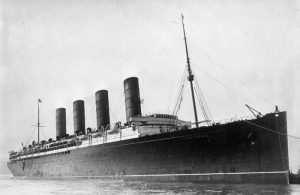 Most people have heard of the Titanic sinking, and how disaster could have been prevented, had they just slowed down, listened to the warnings, and had they had enough lifeboats. There is, however, another ship sinking that not so many people have heard of, or if they had, they didn’t pay much attention to. It is the Lusitania. Like the Titanic, the sinking of the Lusitania could have been prevented too, had a number of simple precautions been taken, such as not to sail at all that fateful May day in 1915.
Most people have heard of the Titanic sinking, and how disaster could have been prevented, had they just slowed down, listened to the warnings, and had they had enough lifeboats. There is, however, another ship sinking that not so many people have heard of, or if they had, they didn’t pay much attention to. It is the Lusitania. Like the Titanic, the sinking of the Lusitania could have been prevented too, had a number of simple precautions been taken, such as not to sail at all that fateful May day in 1915.
RMS Lusitania left New York for Britain on May 1, 1915, unfortunately during a time when German submarine warfare was intensifying in the Atlantic. On February 4, 1915, Germany had declared the seas around the United Kingdom a war zone, and the German embassy in the United States had placed newspaper advertisements warning people of the dangers of sailing on Lusitania. Not to defend the Germans, but they had warned people that they would attack all ships, military or passenger. Unfortunately, not many people boarding Lusitania that morning had time to read the paper before embarking on their journey. It amazes me that it was left to the people, who were told that the ship could outrun the German U-boats. They were also told that they 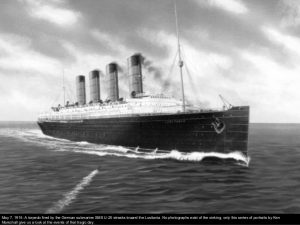 would have escort ships as they entered the war zone. And, they were told that the U-boats were not attacking neutral passenger liners. Unfortunately, these things were not factual. Part of the problem was that the Allies had begun disguising war ships as passenger ships on the assumption that the Germans would not attack passenger ships. Other passenger ships were actually used to transport soldiers and ammunition, or even just ammunition, in the thought that they would be safe from harm that way. The Allies were also supposed to have escort ships to take the passenger ships, but that did not happen in the case of the Lusitania.
would have escort ships as they entered the war zone. And, they were told that the U-boats were not attacking neutral passenger liners. Unfortunately, these things were not factual. Part of the problem was that the Allies had begun disguising war ships as passenger ships on the assumption that the Germans would not attack passenger ships. Other passenger ships were actually used to transport soldiers and ammunition, or even just ammunition, in the thought that they would be safe from harm that way. The Allies were also supposed to have escort ships to take the passenger ships, but that did not happen in the case of the Lusitania.
The sinking of the Cunard ocean liner RMS Lusitania occurred on Friday, May 7, 1915 during the First World War, as Germany waged submarine warfare against the United Kingdom which had implemented a naval blockade of Germany. The ship was identified and torpedoed by the German U-boat U-20 and sank in just 18 minutes, and also took on a heavy starboard list. The Lusitania went down 11 miles off the Old Head of Kinsale, 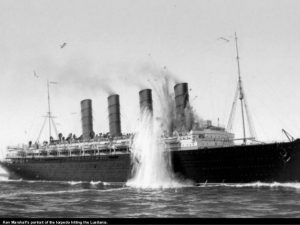 Ireland, killing 1,198 and leaving 761 survivors. The sinking turned public opinion in many countries against Germany, and it was a key element in the American entry into World War I. The torpedoing and subsequent sinking became an iconic symbol in military recruiting campaigns. The injustice of it brought about the outrage that would likely cause soldiers to enlist. Still, the United States did not immediately enter into the war. The American government first issued a severe protest to Germany…a waste of time really. Then, following immense pressure from the United States and recognizing the limited effectiveness of the policy, Germany abandoned unrestricted submarine warfare in September 1915.
Ireland, killing 1,198 and leaving 761 survivors. The sinking turned public opinion in many countries against Germany, and it was a key element in the American entry into World War I. The torpedoing and subsequent sinking became an iconic symbol in military recruiting campaigns. The injustice of it brought about the outrage that would likely cause soldiers to enlist. Still, the United States did not immediately enter into the war. The American government first issued a severe protest to Germany…a waste of time really. Then, following immense pressure from the United States and recognizing the limited effectiveness of the policy, Germany abandoned unrestricted submarine warfare in September 1915.
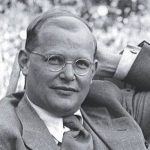 I think we have all thought that the German people were in agreement with the Nazis, but there were, in fact, many German people who fought hard for the other side. One such person who was active in the German resistance was Dietrich Bonhoeffer, who was a Protestant Lutheran Pastor and theologian. He hated Nazism and Hitler’s horrific ideas, and his strong hatred of these things brought him to a place of knowing that he had to do something…anything to stop the murderous regime.
I think we have all thought that the German people were in agreement with the Nazis, but there were, in fact, many German people who fought hard for the other side. One such person who was active in the German resistance was Dietrich Bonhoeffer, who was a Protestant Lutheran Pastor and theologian. He hated Nazism and Hitler’s horrific ideas, and his strong hatred of these things brought him to a place of knowing that he had to do something…anything to stop the murderous regime.
Bonhoeffer was born February 4, 1906 in Breslau, Germany. His family were not religious, but had a strong musical and artistic background. From his childhood days, Bonhoeffer displayed great musical talent, and the pursuit of music was important to him throughout his life. As he grew, I’m sure his family had great plans for his musical future…hoping for him to be a famous musician. When Bonhoeffer turned 14, he announced that he wanted to train and become a priest…a revelation that completely shocked his family.
Despite their displeasure at his announcement, Bonhoeffer attended the University of Berlin, graduating in 1927 with a doctorate in theology for his influential thesis, Sanctorum Communio, which means Communion of Saints. After his graduation, Bonhoeffer spent time in Spain and America. This was likely a good thing, because it gave him a wider outlook on life and helped him move from academic study to a more practical interpretation of the Gospels. He became quite interested in the concept of the Church’s involvement in social justice and protection of those who were oppressed. His wide travels also encouraged a greater interest in ecumenism, which is the outreach to other churches.
At the age of 25, Bonhoeffer was ordained as a priest. Because the early 30’s were a period of great upheaval in Germany, with the instability of Weimar Germany and the mass unemployment of the Great Depression leading to the election of Adolf Hitler in 1933. Hitler was elected as Chancellor in January 1933. He was very charismatic, and therefore, widely welcomed by most of the German people, including large parts of the church, but Bonhoeffer saw through the façade, and remained a firm opponent of Hitler’s philosophy.
Two days after Hitler’s election as Chancellor in Jan 1933, Bonhoeffer made a radio broadcast criticizing Hitler, and in particular the dangers of the idolatrous cult of the Fuhrer. The radio broadcast was almost immediately cut off. Apparently, Hitler already had a large amount of control of the information people received. Being an opponent of Hitler in those days was not looked upon favorably, and unfortunately, they did not have the freedom of speech that we enjoy in the United States.
Many people and even churches were fooled by Hitler, and before they realized it, they had lost the right to do anything about it. Bonhoeffer tried to organize the Protestant Church to reject the Nazi ideology, but they did not listen so he had to breakaway from the church where he was ordained. In April 1933, The Confessing Church which Bonhoeffer helped form with Martin Niemoller, was born. The Confessing Church sought to stand in contrast to the Nazi-supported, German Christian movement. Bonhoeffer felt disillusioned by the weakness of the church and opposition, and in the autumn of 1933, he took a two-year appointment to a German-speaking Protestant church in London.
After two years in London, Bonhoeffer returned to Berlin. He felt like he should be with his native country and  share in its struggles, even if it looked like there was no hope. Shortly after his return, one leader of the Confessing Church was arrested and another fled to Switzerland. Bonhoeffer’s authorization to teach revoked in 1936. He could not teach after being denounced as a pacifist and enemy of the state. Things grew steadily worse, and finally, because of his opposition to the Nazi regime, Bonhoeffer was arrested. He was “sentenced” to death and on April 9, 1945, was executed at the Flossian concentration camp. It was the last month of the war. He had almost survived. He remains an important symbol of opposition to Hitler, and his views on Christianity continue to be influential.
share in its struggles, even if it looked like there was no hope. Shortly after his return, one leader of the Confessing Church was arrested and another fled to Switzerland. Bonhoeffer’s authorization to teach revoked in 1936. He could not teach after being denounced as a pacifist and enemy of the state. Things grew steadily worse, and finally, because of his opposition to the Nazi regime, Bonhoeffer was arrested. He was “sentenced” to death and on April 9, 1945, was executed at the Flossian concentration camp. It was the last month of the war. He had almost survived. He remains an important symbol of opposition to Hitler, and his views on Christianity continue to be influential.
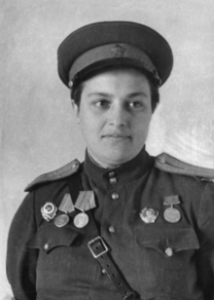 Lyudmila Mikhailivna Pavlichenko was a Soviet sniper in the Red Army during World War II, credited with 309 confirmed kills. Her record made her the most successful female sniper in history. Lyudmila was nicknamed “Lady Death” due to her incredible ability with a sniper rifle and her high kill count. She served in the Red Army during the Siege of Odessa and the Siege of Sevastopol, during the early stages of the Eastern Front in World War II. Born Lyudmila Mikhailovna Belova on July 12, 1916 in Bila Tserkva, Russian Empire (located within present-day Ukraine). Her mother was a teacher and her father was a Saint Petersburg factory worker.
Lyudmila Mikhailivna Pavlichenko was a Soviet sniper in the Red Army during World War II, credited with 309 confirmed kills. Her record made her the most successful female sniper in history. Lyudmila was nicknamed “Lady Death” due to her incredible ability with a sniper rifle and her high kill count. She served in the Red Army during the Siege of Odessa and the Siege of Sevastopol, during the early stages of the Eastern Front in World War II. Born Lyudmila Mikhailovna Belova on July 12, 1916 in Bila Tserkva, Russian Empire (located within present-day Ukraine). Her mother was a teacher and her father was a Saint Petersburg factory worker.
In June 1941, when Pavlichenko was 24 years old and in her fourth year studying history at Kiev University, Germany began its invasion of the Soviet Union. Pavlichenko was among the first round of volunteers at the Odessa recruiting office, where she requested to join the infantry. The registrar really wanted her to be a nurse, but she refused. She surprised her superiors, and after they saw that she had completed multiple training courses, they finally let her in the army as a sniper. Pavlichenko was assigned to the Red Army’s 25th Rifle Division. She became one of 2,000 female snipers in the Red Army. The number sounds large, but female soldiers were still just 2% of the Red Army’s total number. Of the 2,000 female snipers, only about 500 survived the war. Pavlichenko was given only a frag grenade due to weapon shortages, although she was in a combat role. On August 8, 1941 a fallen comrade handed her his Mosin-Nagant model 1891 bolt-action rifle. She finally had a real weapon, and with it she achieved her first two kills and proved herself to her comrades. She described this event that made her officially a sniper, her “baptism of fire.”
Pavlichenko fought for about two and a half months near Odessa, where she recorded 187 kills. She was promoted to Senior Sergeant in August 1941, when she reached 100 confirmed kills. At age 25, she married a fellow sniper whose name was Alexei Kitsenko. Unfortunately, soon after the marriage, Alexei was gravely wounded by a mortar shell. He died from his injuries after a few days in the hospital. When the Romanians gained control of Odessa on October 15, 1941, Pavlichenko’s unit was withdrawn by sea to Sevastopol on the Crimean Peninsula, where she fought for more than eight months. In Sevastopol, Pavlichenko trained almost a dozen snipers, who killed over a hundred Axis soldiers during the battle. In May 1942, newly promoted Lieutenant Pavlichenko was cited by the Southern Army Council for killing 257 Axis soldiers. Her total of confirmed kills during World War II was 309, including 36 enemy snipers. In June 1942, Pavlichenko was hit in the face with shrapnel from a mortar shell. After her injury, the Soviet High Command ordered that she be evacuated from Sevastopol by submarine. They didn’t want to lose this valuable, perfect example of Soviet womanhood. She spent around a month in the hospital, after which she expected to go back to the Eastern Front , but she didn’t. Instead she became a propagandist for the Red Army. She also trained snipers for combat duty till the end of the war in 1945.
In 1942, Pavlichenko was sent to Canada and the United States for a publicity visit. Her mission was to convince the allies to start a second front against Nazi Germany. When she visited the United States, she became the first Soviet citizen to be received by a US President, as Franklin D. Roosevelt welcomed her to the White House, and later she toured with Eleanor Roosevelt across America, relating her experiences as a female soldier on the front lines. Unfortunately, Pavlichenko was not taken seriously by the press during her tour, but was referred to as the “Girl Sniper.” I can’t imagine how the press could possibly connect a sniper with girlish innocence. She was dumbfounded by the kind of questions reporters put to her in Washington, DC. “One reporter even criticized the length of the skirt of my uniform, saying that in America women wear shorter skirts and besides my uniform made me look fat.” They also asked if she used makeup on the front line. She was described by the reporters as very blunt and unemotional in her responses. Pavlichenko appeared before the International Student Assembly being held in Washington, DC, attended the meetings of the Congress of Industrial Organizations, and made appearances and speeches in New York City and Chicago. In New York City, she was given a raccoon fur coat by Mayor LaGuardia. In Chicago, she stood before large crowds, chiding the men to support the second front. “Gentlemen,” she said, “I am 25 years old and I have killed 309 fascist invaders by now. Don’t you think, gentlemen, that you have been hiding behind my back for too long?” Her words settled on the crowd, then caused a surging roar of support.
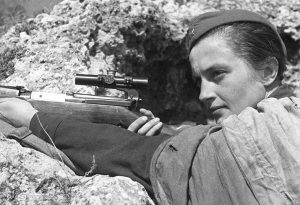 On Friday, November 12, 1942, Pavlichenko visited Coventry, accepting donations of £4,516 from local workers to pay for three X-ray units for the Red Army. She also visited Coventry Cathedral ruins, then the Alfred Herbert works and Standard Motor Factory, from where most funds had been raised. She had inspected a factory in Birmingham earlier in the day. Having attained the rank of major, Pavlichenko never returned to combat, but became an instructor and trained Soviet snipers until the war’s end. In 1943, she was awarded the Gold Star of the Hero of the Soviet Union, as well as the Order of Lenin twice. Lyudmilla Pavlichenko died on October 10, 1974, at the age of 58 years in Moscow, Soviet Union due to a stroke. She was a beloved hero of the Soviet Union.
On Friday, November 12, 1942, Pavlichenko visited Coventry, accepting donations of £4,516 from local workers to pay for three X-ray units for the Red Army. She also visited Coventry Cathedral ruins, then the Alfred Herbert works and Standard Motor Factory, from where most funds had been raised. She had inspected a factory in Birmingham earlier in the day. Having attained the rank of major, Pavlichenko never returned to combat, but became an instructor and trained Soviet snipers until the war’s end. In 1943, she was awarded the Gold Star of the Hero of the Soviet Union, as well as the Order of Lenin twice. Lyudmilla Pavlichenko died on October 10, 1974, at the age of 58 years in Moscow, Soviet Union due to a stroke. She was a beloved hero of the Soviet Union.

